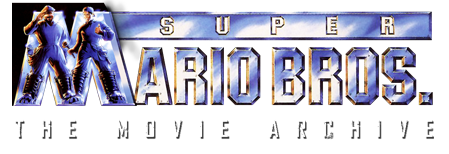Exclusive Interviews
Scott Mactavish - SMB Archive Interview: 01/06/2011 by Steven Applebaum

Scott Mactavish first agreed to this interview upon the site's revival back in October, only to seem lost upon mutual distractions. Therefore it came as a nice surprise when he E-mailed me back several months later, commenting on the Mark Jeffrey Miller & Mike Harding dual-interview. It seems he actually was a true Goomba rather than simply a "Goomba wrangler" and was once again up for the interview to help clear up the confusion.
As a filmmaker in his own right, Scott offered a very informative and insightful look into the production with more focus than many of our other interviews. Both humorous and thoughtful, Scott is certainly a Goomba to be remembered.
Steven Applebaum: Thank you for taking the time to conduct this interview, Scott. To begin, could you tell us a bit about how you got into acting and stunt-work?
Scott Mactavish: I attended film school at NYU, and quite literally 'tried' acting just to get a feel for the directing process. I gave myself two years and landed 98% of the roles I auditioned for, mainly smaller theater productions and indie films.
As for the stunt work, I was the guy closest to the set that had a SAG card and a background in athletics and martial arts. Acting was a blast, but I 'retired' from the craft shortly after SMB to focus on writing, producing and directing.
I did a few small theater roles as favors to friends in the late 90s, but otherwise, stay behind the camera.
SA: Were you familiar with the Super Mario video games before becoming involved with the film? If not, did you take the time to look into them?
SM: I played the original SMB back when I was in the Navy. We would have epic off-duty SMB battles and most of us could rescue Daisy after a few weeks.
These days, they play Call of Duty and MOH. The times, they are a changin'.
SA: How did you find out about Super Mario Bros.? Did anything in particular make you interested in auditioning?
SM: After film school, I moved to Wilmington, NC to check out the movie scene. Back in those days, 'Wilmywood' was a huge production hub for films and TV series. I bought an old truck and drove from NYC to Wilmington, rented a small apartment, and registered with the local casting directors, the Fincannons.
Within a couple of weeks, I was working as an extra on 'Amos and Andrew' with (Nicolas Cage and Samuel Jackson,) and Matlock. While most of the extras hung out in the big tents, I wandered around the set to learn as much as possible about the movie machine. I was far more interested in meeting the producers than Nicolas Cage. Rumors started circulating about SMB coming to town, and I saw it as another learning opportunity. I told Lisa Fincannon to work me anywhere they needed bodies.
SA: Do you remember at what point in the production you came on and how long you worked on-set?
SM: They filmed in a huge abandoned cement factory about 15 miles outside of Wilmington. I made a number of crew friends on Amos and Andrew, and knew that they were working in early spring, setting up the production offices and building sets. If I recall correctly, I started about two weeks into production, working with the Special Effects team. In one scene, you can see me in a cop uniform shooting a flame thrower. In another, I'm wrestling with a prisoner beside one of the jail 'cages.' The jail scene was technically an 'extra' role but it got really physical. I was new to the game, and didn't know any better. I just liked being there.
Anyway, one of the crew guys pulled me aside and said I should ask for more money for doing all of that 'stunt' work. It was around this time that the Goombas started working, and I helped the MEL guys around the shop. The other Goomba actors were in town, and making crazy money for the role. A week or so later, they needed another 'official' Goomba and Lisa Finacannon asked if I wanted it. I said yes, and was 'bumped' up to the full role.
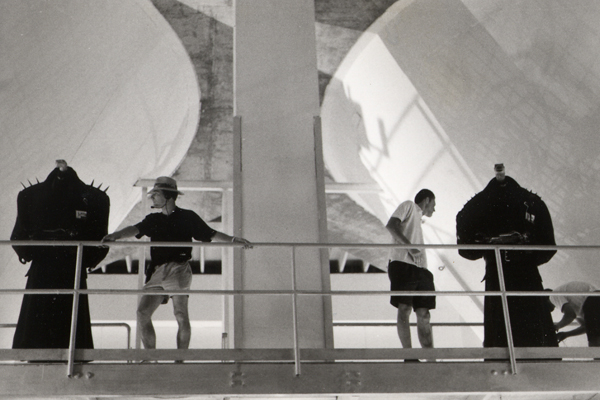
Photo courtesy of MEL
Checking out the top of the Devo Chamber
SA: Mike Harding, another Goomba actor we've interviewed, stated that you were never an actual Goomba, but a "Goomba wrangler" that "may" have suited up once or twice as an extra. How do you respond to that?
SM: [...] I was a Goomba actor, not wrangler. I suited up nearly every day and appeared in dozens of scenes. Caleb was a wrangler and I believe that's who he's referring to. To be clear, I started out doing basic stunt and SFX stuff, but got 'bumped' to the actor role two weeks in when another actor bailed on the project.
We had five 'actor' Goombas, one 'main' toadhead Goomba that was operated by John [Fifer] from MEL, and a dozen 'stunt' Goombas, meaning full Goomba costumes without the mechanical guts. I was hired early on to assist with other non-Goomba SFX stuff, but was promoted to an official 'actor' Goomba role after a couple of weeks (and thus the closing credit.) On any given day we had a dozen extras coming and going that would suit up in the 'stunt' suits for group shots. We also had wranglers that would escort the Goombas to and around set.
SA: Did you initially audition for a role other than the ones you received? Do you know how you came to receive the different roles you did?
SM: Now that I think about it, I did audition for a bartender role that was later cut. I'm glad I didn't get it, because it would have lasted a few days. The Goomba role lasted several months.
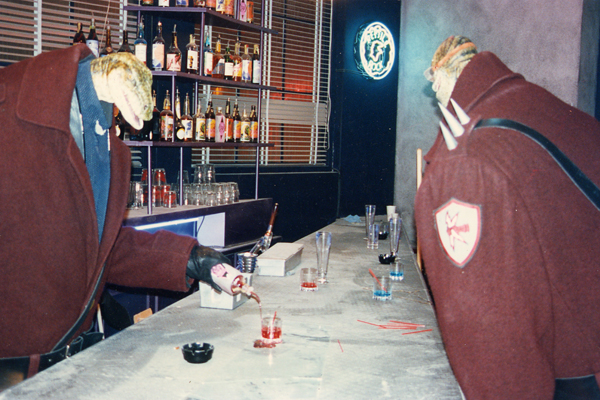
Photo courtesy of MEL
Goomba 1: "What'll it be?" Goomba 2: "A Reptile Rock...on the rocks." Goomba 1: "Jolly good."
SA: We know that the actors for the Goombas had to be very tall to operate the Goomba costumes. How tall are you? Compared to the other actors?
SM: I'm 6'2", same as the late, great Thomas. Mike L. and Wally were very tall, 6' 5" or more. Mike H. is probably 6' 3".
SA: Can you briefly explain how the Goomba costume was operated and how difficult it was to learn the various processes?
SM: We wore metal harnesses on our shoulders and backs. The rig had a hat-like piece that connected to the bottom of the Goomba head, causing the Goomba's left/right head movement to match the actor's. The rig was wrapped in a foam shell and covered with a huge wool coat. The coat had a one fake arm and hand so that the actor could use a lever inside the suit to make the Goomba's mouth 'talk.' We all wore headpieces and took directions from the puppeteers offstage. For example: "Scott, take three steps forward, stop, look left, say three words."
It was easy to operate and get the 'process' down, but the suits were hot as hell. Several of the 'extra' Goombas collapsed from heat in the hot NC summer. They eventually installed small fans in the suits to promote a safer (and cooler) work environment. The suit weighed close to 100 pounds, and we were essentially blind to our surroundings. We required a 'wrangler' to walk us from scene to scene, literally leading us by hand.
SA: Unlike the ape-head, the lizard-head Goomba had a snakelike tongue seen in several scenes. Did you operate a lizard-head with that feature? Did you control the tongue or did an off-screen MEL puppeteer do so?
SM: All of the main Goombas had animated facial features that the puppeteers controlled offstage. Blinking eyes, pulsing throats, etc.
SA: While the lizard-head Goomba was in about as much scenes as the ape-head it was unfortunately rarely in the forefront. Do you know why it was less center-stage?
SM: Purely a call by the director and puppeteers. The ape head was actually called a toad head, and there was one 'main' Goomba for close-ups, that happened to be a toad head. He was the one that played harmonica.
SA: How did being a Goomba compare to being Mark Twain?
SM: Hmmmm...I think you mean Henry Thoreau? It's like comparing apples to cannon balls. Thoreau was a stage play with 104 pages of dialogue and I had 85 of those pages. Goomba was, well, a no-dialogue, 7 ft. lizard man. I will say I made very little for the play, compared to Goomba wages.
SA: What was your relationship and interactions with the other Goomba actors and MEL? How well were you treated for your role?
SM: Greatly enjoyed working with all of them. The MEL guys were great and very funny. They treated us all very well and it was a blast, really. One other note. There was a riverside blues bar in downtown Wilmington that we took over for the shoot. They had an open stage policy several times a week, and several of the Goombas, myself included, had played in bands. (Drums in my case.) There were numerous epic Goomba jam sessions that had the entire bar jumping.
SA: The death of Thomas Merdis, another Goomba, is noted on your website. Is there anything you can tell us about him and his contribution to the film to honor his memory now that we no longer have the opportunity to speak with him ourselves?
SM: Thomas was actually a pretty accomplished actor with a number of nice roles in big blockbuster films. He was a pretty quiet guy, but very funny when you got him worked up. He was also a Viet Nam vet (Air Force) and one of the first brother vets I ever worked with on a film set. We lost touch after SMB but he was a good dude.
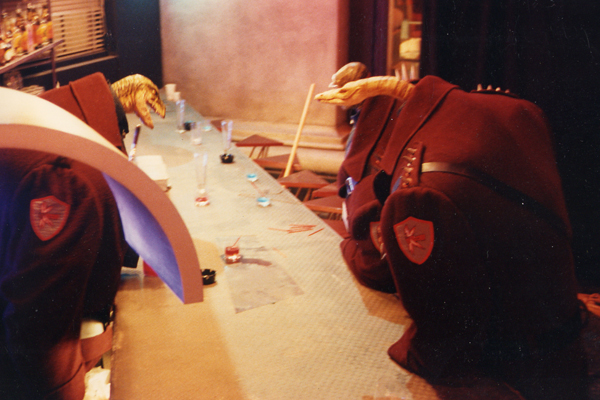
Photo courtesy of MEL
Eavesdropping on some Goombas (and at all three types at once!)
SA: We heard from script supervisor Marita Grabiak that the idea for Luigi to distract the Goombas in the elevator by making them dance was a spontaneous decision by co-director Annabel Jankel. Do you recall how the scene was originally meant to play out and how the other Goombas and yourself reacted to the idea?
SM: No idea. By then, there was PLENTY of improvisation going on. The Goombas did very little script reading. We normally suited up and took direction directly from the MEL guys.
SA: What was it like traveling through the ice tunnel? We heard from Mike Harding, also a Goomba, that it was just as painfully slow as it looks on-film, mostly due to the fact that the Goombas kept falling off.
SM: Yes, it was tedious and bizarre. By the time they shot this scene Dean Semler was directing the movie. Dean is a brilliant cinematographer; he won an Oscar for Dances with Wolves. Harding's memory is good; it was damn near impossible to balance upright on that sled, and we kept tipping over.
SA: As a stunt actor, what are you expected to do in a film? What did you do for Super Mario Bros.?
SM: For SMB, early on I was an extra that was asked to do stunt-like work such as wrestling with 'cops' and climbing cages. As I mentioned above, one of the crew guys recommended I ask for more money and a screen credit, but I was having too much fun. I'm glad I rolled with it, because it led to the Goomba gig.
Not long after SMB, I worked as a photo double for Bob Brown, one of the main stunt guys on The Crow. I mainly stood in for him between takes, while they lit the set and loaded blanks in the guns. Again, a huge learning opportunity.
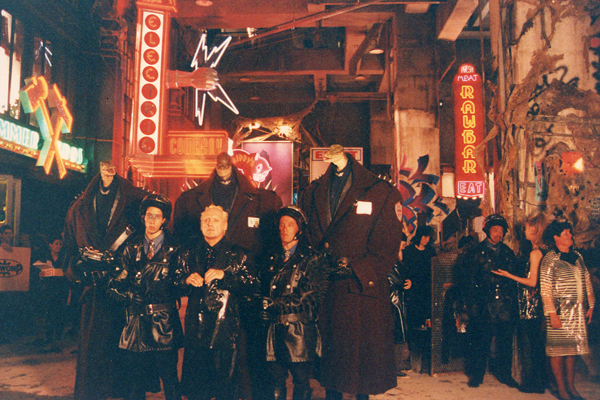
Photo courtesy of MEL
"I suppose [Super Mario Bros.] has some campy appeal, like Showgirls without the boobies." (Scott's on the left)
SA: Were you or anyone else ever seriously hurt in the course of performing a stunt?
SM: I was not. One stunt performer bounced out of the back of a dumptruck and broke his arm, and Bob Hoskin's stand-in was almost hit by a fireball fired from a Goomba gun. Can't recall the others...
SA: Do you remember any scenes or alternate takes involving Goombas or stunt-work that was either cut or changed due to not working out as planned?
SM: Can't recall.
SA: Did you have any interaction with the lead cast or members of the production, such as the directors, producers, or anyone else? If so, what was your experience with them?
SM: As I mentioned previously, I became close to one of the Executive Producers and his family, and still maintain a friendship today. Probably shouldn't name drop, so I won't. Anyhow, his three kids were teens at the time, and they came over from Europe to help their dad on the set. We (the Goombas) played music to pass the time, and kids would join in on guitar, drums, etc. They would hang out in the 'Goomba Cave' with us and the MEL guys, and were very pleasant, down to earth teens. Especially given the fact that their dad is a major player. Today, the kids are all grown and working in non-film careers, and they're all Facebook friends of mine.
In terms of lead cast, Leguizamo and I became friends and stayed in touch for a while, but then drifted apart. A number of the crew guys are still very good friends, and several have built great careers. In one case, a buddy of mine dropped out of college and offered to sweep sets or take out the trash, anything to break into movies. He worked hard, and is now a Production Coordinator making big coin. SMB was his first gig.
SA: Overall, how was your experience? We've heard that, despite the production's turmoil, it was a fun experience during which lots of friends were made and parties were had. How did your experience compare?
SM: It was a blast that paid very well, and led to good friendships that last to this day.
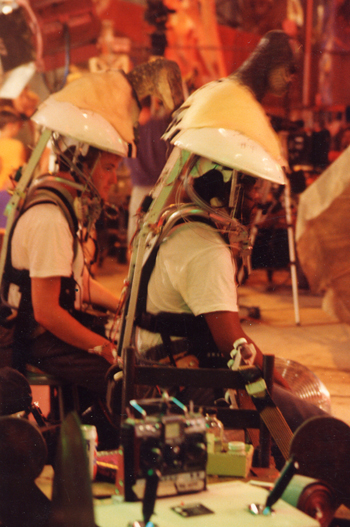
Photo courtesy of MEL
"[Super Mario Bros.] was a blast that paid very well, and led to good friendships that last to this day." (Scott's on the left)
SA: What did you think of the movie when you first saw it?
SM: It's weird sitting through a screening of a film in which you performed. You tend to block out the story and focus on individual scenes that bring back good memories, such as 'that one day that Mike fell out of the ice tunnel,' or whatever. I do recall leaving the theater thinking: Well, there will be no sequel! (They had talked of one early in the film.)
SA: That's interesting to hear as we've asked several people before about a possible sequel and have always been told it was never seriously considered. Do you recall exactly when a sequel was discussed, by whom, and to what extent?
SM: We got word of a possible sequel from MEL, and they probably got it from the water cooler. The conversations were more speculative, such as "Hey Scott, would you be available for a sequel if they shoot one?"
All of this talk started when Jeff Katzenberg came to set. He was with Disney then (and of course, went on to found Dreamworks with Spielberg and Geffen. Told ya I was geeked out on production details). Anyway, when Disney bought in, that triggered much speculation. I have no doubt that had the film made money, Disney would have made a sequel.
SA: Have you watched the movie since and, if so, has your opinion of it changed over time?
SM: I've watched it with my young sons and always have a great laugh. It is what it is; a grand idea that was poorly executed.
SA: What have you done since Super Mario Bros.? What are you up to these days?
SM: I founded and run a film production company out of NYC, and write books on the side, including a (minor) humorous best-seller on fatherhood.
SA: As you're a producer and director I'm interested in your take on the film's production. Where would you say the blame fell in this particular case? Could anything have been done to make the film work before it was too late or was it doomed from the outset?
SM: That's easy...the script was nonsensical, and hiring a husband/wife team to co-direct was the kiss of death. I will say, I became friends with one of the producers, who has a massively successful career aside from SMB. We remain friends to this day.
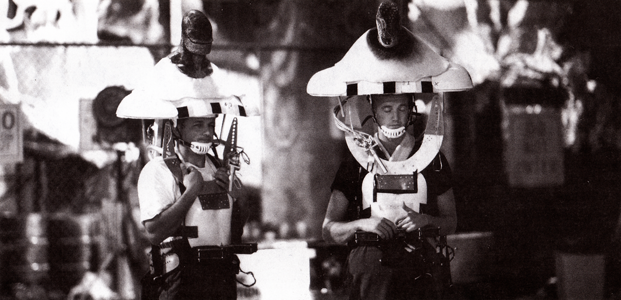
That's Scott on the right
SA: As a filmmaker, perhaps you might have an opinion on what could be done with the movie now. We've been pushing for a remastered and re-cut re-release of the movie, which several people we've interviewed, including production designer David Snyder and editor Mark Goldblatt, have backed. Considering the film has nearly 30 minutes of cut footage do you think anything can be done to make the movie work better on a more technical or enjoyable level?
SM: I really can't opine without knowing what footage exists. I do know that re-cutting and re-releasing could be very expensive, and given the initial response to the film, you're unlikely to find any studio types willing to gamble on it.
SA: Do you have any other interesting stories to tell or a message for us fans?
SM: It's cool that fans actually care about the film. I suppose it has some campy appeal, like Showgirls without the boobies.
SA: Finally, do you have any photos or other memorabilia from your time in the movie you can share with us for the site?
SM: I'm actually in one of the photos on your site, the one where we're wearing the rigs. I'm the guy on the right as you face the photo. I may have some others lying around. I'll send them to you if they show up. Also, I've run across Goomba action figures on the internet, which is quite badass.
Also, one other thing about the set. The city 'Dino York' they built inside the cement factory was a fully functional town. For example, the doughnut shop could actually make doughnuts. They spent insane money on set design and construction. When you see the group scenes in Dino York, check out the background.
Hope this helps!
SA: Thanks for the interview, Scott. It's great knowing you can see the film for its cult status. Knowing you had just as much a blast making it as we have watching it today only helps solidify that status.
